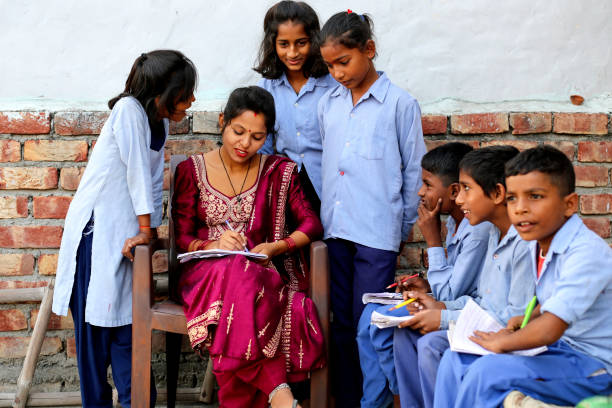
Implementation of Foundational Literacy and Numeracy in Schools
The National Education Policy (NEP) 2020 has emphasized the need for foundational literacy and numeracy (FLN) by Standard 2, recognizing it as a critical milestone for students’ educational progress. Despite significant efforts by central and state governments to implement various initiatives, there is limited information on how these changes have influenced teaching and learning in classrooms.
A study conducted by Bhattacharjea, Bhutada, and Bisht examined classroom observations and teacher interviews across eight Indian states to assess the impact of FLN policies. The study focused on aspects such as classroom composition, teacher attitudes, and teaching methodologies.
National Framework for Foundational Literacy and Numeracy
The NEP 2020 highlights FLN as a fundamental goal, stating that future educational reforms will only be effective if children achieve basic reading, writing, and arithmetic skills at an early stage. To achieve this, the National Initiative for Proficiency in Reading with Understanding and Numeracy (NIPUN) Bharat Mission was introduced, setting a structured roadmap with learning goals to be met by 2026-27.
NIPUN Bharat emphasizes inclusive classrooms, play-based learning, and the use of teaching-learning materials (TLM). As of January 2025, all Indian states and Union Territories have adapted and implemented FLN programs, including capacity-building initiatives for teachers and preparatory modules such as ‘Vidya Pravesh’ for Standard 1 students.
Indicators of FLN Implementation
The Annual Status of Education Report (ASER) 2024 offers insights into FLN implementation. Data from 15,728 schools reveal:
- Over 80% of schools received government directives to conduct FLN activities for Standards 1-3.
- Teaching-learning materials (beyond textbooks) were observed in over 85% of Standard 1 and 2 classrooms.
- More than 75% of schools had at least one teacher trained in FLN through in-person sessions.
However, ASER does not provide comprehensive insights into how these interventions have altered classroom learning experiences.
Classroom Observations and Teacher Interviews
In mid-2024, ASER Centre researchers conducted an in-depth study in Standard 2 classrooms across 24 schools in eight states: Assam, Chhattisgarh, Himachal Pradesh, Madhya Pradesh, Odisha, Rajasthan, Uttar Pradesh, and West Bengal. Schools were selected to represent rural remote, rural well-connected, and urban settings.
Key findings included:
Classroom Composition
The structure of Standard 2 classrooms varied significantly across schools. While the NEP-recommended teacher-student ratio of 1:30 was maintained in most cases, more than 60% of classrooms were multigrade, meaning multiple grades studied together. This variation was most common in rural areas.
In addition to teaching responsibilities, many teachers handled administrative duties, such as student record-keeping, which reduced their time for instruction.
Teacher Attitudes Towards Young Learners
Most teachers acknowledged that the foundational years require a distinct approach. Many emphasized the importance of making students feel comfortable before focusing on academics. Teachers exhibited warmth and positive reinforcement, frequently engaging with students by name and offering encouragement.
However, some traditional biases persisted. Many teachers still classified students as ‘bright’ or ‘weak,’ which influenced their perception of learning potential.
Teaching Methods and Learning Activities
Although traditional chalk-and-talk methods remained prevalent, some shifts in teaching approaches were observed:
- Student Participation: Teachers attempted to engage most students, even those seated at the back of the classroom.
- Contextual Learning: Many teachers incorporated local examples to make learning more relatable.
- Use of Teaching Aids: In 17% of observed lessons, teachers used additional TLM beyond textbooks, such as workbooks and educational games.
- Interactive Teaching: Some teachers moved around the classroom or sat with students on the floor to foster engagement.
Despite these efforts, play-based learning—recommended under NIPUN Bharat—was rarely observed. Instead, traditional methods like choral repetition remained dominant, with students repeating after the teacher rather than engaging in exploratory learning.
Challenges in FLN Implementation
While the study found encouraging changes in teacher attitudes and classroom engagement, several challenges remain:
- Multigrade Classrooms: Managing different grade levels simultaneously limits focused instruction for Standard 2 students.
- Administrative Burden: Teachers spend significant time on documentation, reducing their ability to implement interactive teaching.
- Limited Play-Based Learning: Despite policy recommendations, structured play-based activities were rarely incorporated.
Conclusion
The NEP 2020 has spurred nationwide efforts to enhance foundational literacy and numeracy, and initiatives like NIPUN Bharat have provided clear guidelines for achieving these goals. However, effective implementation depends on how these strategies are translated into classroom practices.
The study highlights that while teachers are actively engaging with students, traditional teaching methods continue to dominate. Moving forward, greater emphasis on interactive learning and reducing administrative workload could enhance the effectiveness of FLN programs.
By addressing these challenges, India can ensure that foundational learning objectives are met, laying a strong educational foundation for young learners.










